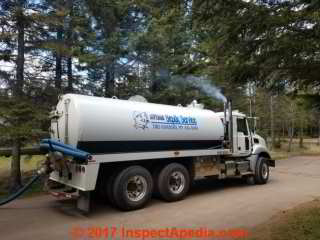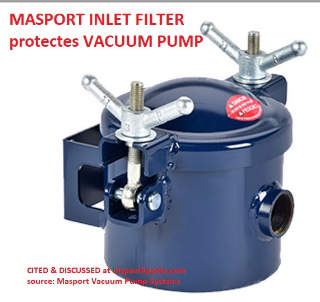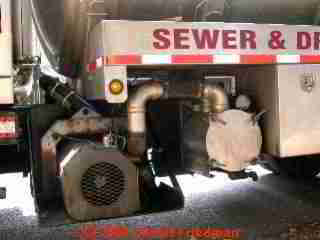 Septic Pumper Truck Vacuum Pumps
Septic Pumper Truck Vacuum Pumps
Pumper truck vacuum pumps, types, choices, specifications, lift capacity, speeds, rotary vane & air assist vacuum pump sources
- POST a QUESTION or COMMENT about vacuum pumps, lift pumps, septic pumper truck pumps, septic tank pumper truck operation and procedures
Septic pumper truck vacuum pumps:
Pump types, capacities, choices, specifications for septic pumper trucks or septic tank cleaning systems & grease trap cleaning systems.
This article series describes the steps in septic pumper truck operation during septic tank or grease trap cleaning and service. We describe the septic pumper truck operator's steps and the septic tank vacuuming procedure.
InspectAPedia tolerates no conflicts of interest. We have no relationship with advertisers, products, or services discussed at this website.
- Daniel Friedman, Publisher/Editor/Author - See WHO ARE WE?
Septic Tank Pumper Truck Vacuum Pump Systems
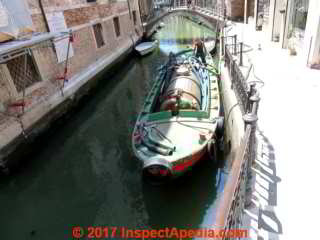 Daniel Friedman & Mike Rost
Daniel Friedman & Mike Rost
How does a septic pumper truck work?
Septic pumper trucks use a powerful vacuum pump that creates a vacuum inside the receiving tank mounted on the truck body.
Is a pumper "truck" always used to empty a septic tank. Well pretty-much always but there are exceptions such as we show in our photo of a septic pumper boat in a Venetian canal.
[Click to enlarge any image]
A hose connected to the receiving tank inlet is used to agitate and vacuum up the floating scum layer, settled sludge layer, and liquid effluent that make up a septic tank's contents.
The actual vacuum pump and all of its protective filters are downstream from the tank that receives the solids and liquids comprising septage or septic tank contents, and the pump itself is protected by a series of filters and controls that prevent any liquids or solids from entering the vacuum pump itself, lest the pump be damaged.
In typical use the septic pumping or tank cleaning company's pumper truck and its hoses are used to empty the septic tank of all of its sewage.
In some septic tank cleaning procedures, fresh water is then added to the tank to permit an additional rinsing and then an inspection of the tank interior.
Details are at PUMPER TRUCK OPERATION PROCEDURE
When the pumper truck tank is close to full, the driver transports the sewage to an approved dumping facility, often a wastewater treatment plant, where, for a fee, the truck can be emptied.
Venice Sewer System & Venetian Sewage Boats
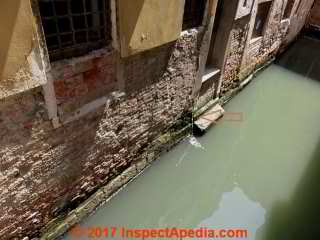 After a quick look at the sewer system in Venice, Italy where we enjoy a look at a pozzo nero sewage pumper boat, we move on to more-widely-used sewer pumping trucks, pumps, & equipment.
After a quick look at the sewer system in Venice, Italy where we enjoy a look at a pozzo nero sewage pumper boat, we move on to more-widely-used sewer pumping trucks, pumps, & equipment.
While most septic tank pumping is performed by a worker using a pumper truck, in Venice, Italy pumper pozzo nero boats have to handle that job as there are no streets passable by motorized vehicles.
The septic pumping boat moors in a canal near the septic tank that needs to be emptied. The pumped-waste is then transported to a disposal site or the sewage treatment plant in Porto Marghera in the 1980's. However for much of Venice sewage continues to empty into the canal system.
Photo: a small stream of rather clear wastewater is emptying into a canal in the San Marco area of Venice. Generally waste pipes that empty into canals are below water-level.
Sewage waste pipes within a building typically connect to a pozzo nero or black well (blackwater well) or septic tank that ultimately discharges into a nearby canal.
Fognatura is the Italian term for the complete system of waste piping, pozzo nero, below-ground tunnels or gatoli, essentially huge pipes emptying into canals through foundation wall openings (sbocchi) and ultimately into the lagoon.
Some of these below-ground components have been in place since the 16th century.
Tidal action is relied-upon to keep the canals acceptably clean.
Tidal action is relied-upon to keep the canals acceptably clean.
Following periods of aqua alta when canal or lagoon water has entered the lower floor of some Venice buildings, cleanup when the hight water recedes includes the use of disinfectants.
A photo of the septic worker connecting the septic pumper boat to the holding tank is shown below and is discussed also
at HOLDING TANK SEPTIC SYSTEMS.
- Carrera, Fabio, "The Inner Canals of Venice, An Informational Infrastructure for An Informational Infrastructure for Maintenance, Management and Planning", URISA (2005) [Copy on file]
- Gianpietro Zucchetta, Una Fognatura per Venezia, Due secoli di progetti, Venezia 1986, ASIN: B006GM6ISE - A sewer for Venice: a story of two centuries of projects, Venetian Institute of Science, Letters and Arts, 1986.
- "Sewage disposal", Venipedia, retrieved 2017/07/23, original source: http://www.venipedia.org/wiki/index.php?title=Sewage_disposal
Back on the mainland we'll take a look at more-typical septic holding tanks and their maintenance.
Limits of Septic Pumper Truck (or boat) Pumping Lift & Distances
 Reader Question: my septic tank is 200 feet horizontally and 20 feet below the septic truck parking spot: will I be able to get the septic tank pumped out?
Reader Question: my septic tank is 200 feet horizontally and 20 feet below the septic truck parking spot: will I be able to get the septic tank pumped out?
24 August 2015 Brad said:
Great site, all the info is appreciated. I have a tank, installed over ten years ago but as of yet unused, on a steep hillside roughly 200 horizontal feet away from where a vac truck could park.
To make issues worse, there is probably close to 20 feet of vertical lift as well.
I know this is a very long run, so I am considering laying a dedicated pipe for pumping next to the sewer line running up grade, I'm thinking 1 1/4" 100 PSI poly pipe.
My thought is that the truck to hook onto the top end of the line and pull, and we could put a trash pump at the tank to push.
What are your thoughts?
There is not really a better location for the tank available, or we would have used it.
Local DEQ selected the site and approved the installation, but its tough for sure.
I have installed 3' of 24" riser over the effluent filter access hole to bring it to grade, so there should be room to manipulate a hose or even lower in a submersible pump.
Thanks for any advice you can offer.
Reply:
Typically with a 2-4" vacuum hose and typical septic pumper truck, the horizontal distance that the pumper expects to handle maxes out at about 150 ft. - before considering the reduction in that length for the lift heights involved. Some trucks carry a 200 ft. 3-inch diameter vacuuming hose.
Septic pumpers, at least some of them, use a rotary vane vacuum pump and have a good lift capacity.
Check with your local pumping company to ask what they can lift.
Our photo shows a septic pumper truck used by David Roeder's Superior Septic Service in Two Harbors, MN.
Mike Rost, at National Vacuum Equipment, a producer / vendor of vacuum equipment in the U.S. offered additional help in answering your question.
Typical small pumper truck rotary vane pump capacities
Most septic pumpers with smaller trucks will be close to their pump lift limit but may be able to do the septic tank pumping job using a traditional rotary vane pump (RVP) widely used in the septic pumping industry.
Traditional rotary vane vacuum pumps operate at 200-300 cubic feet per minute (CFM) and with a standard blower obtain about 13 psi of vacuum.
Using as an example the Juggler™ septic pumper truck, that pumper has a 1,200 gallon (rear), 3,600 gallon (front) capacity, and can pump at a stunning 1,600 cfm at 27" HG vacuum (about 13.2 psi of vacuum).
Without air conveyance these pumps can lift sewage or grease waste about 20-25 feet from pumping source to waste level top in the truck tank.
[Thanks to reader MeHere who who points out that a septic pump's vacuum capacity is usually stated in psi; it's 13 psi not 13" of vacuum; note that at sea level the atmospheric pressure is about 14.7 psi]
Factors Limiting a Septic Pumping Truck or Grease Trap Cleaning System's Pumping Capacity
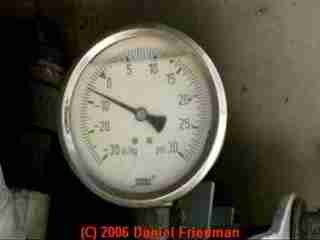 Factors that limit the ability of a septic pumping truck or grease trap cleanout system to pump over distances and high lifts include at least the following:
Factors that limit the ability of a septic pumping truck or grease trap cleanout system to pump over distances and high lifts include at least the following:
- The vertical distance of lift
from tank or trap bottom to waste level inside the truck's tank.
Also see SEPTIC TANK DEPTH and
see SEPTIC TANK DESIGN DEPTH - The pump's vacuum capability.
Even pumps capable of double that vacuum, say 23-25" of vacuum can only lift to about 25 feet unless the lift is aided by air conveyance. - The vacuum pump rating in CFM
(and/or horsepower) and the pump's maximum operating time before overheating (for rotary vane pumps) - The pumping hose diameter,
- The horizontal distance
of hose required - The extent of sharp bends or elbows
(if any) in the pumping hose.
Also see DISTANCE TO SEPTIC TANK - The ability to use air injection or air assist
in the wastage lift. Without air conveyance a typical 13" vacuum 250 CFM septic pumper rotary vane pump can lift about 25 feet of vertical height. - The volume of the receiving tank on the pumper truck:
larger truck volume permits use of air injection to improve lift and pumping speed.
A 3000 gallon septic pumper truck tank is a 400 cubic foot volume (3000 g. / 7.48 cu. ft./gallon).
One inch of vacuum in a typical pumping system can lift about one foot (12"). So at least in theory, 13" of vacuum can lift about 13 feet.
Dekkervacuum points out that
It is important to know the ACFM rating of the [liquid ring vacuum] pump, which expresses the "actual cubic feet per minute" inlet capacity at a specific vacuum level.
... For example, if a specific pump has a displacement of 100 CFM and the volumetric efficiency at 28" Hg gauge is 80%, the actual pump capacity at 28" Hg would be 80 ACFM. - https://www.dekkervacuum.com/
Anver Corp. provides a nice chart of vacuum gauge readings and vacuum lift capacities at various altitudes [ https://anver.com/vacuum-lifters/atmospheric-pressure/ ]
Example: 6.38 psig = 13 in. Hg. = 440.18 -mbar = a 42.9% vacuum.
Without special measures, older 200-300 CFM rotary vane pups may not be up to the job.
That's because the most widely used 250 cubic feet per minute (CFM) rotary vane pump found on at least the smaller septic pumper trucks are too small to make use of additional air flow to get the added lift capacity needed to pump from depth, but a snorkel or other add-on air injection feature might enable pumping even with these units.
But even if the truck and pump can manage the lift, it will take longer with a typical rotary vane pump used on many pumping trucks.
In sum, yes your septic tank can be pumped from 20 feet below the truck parking area though you will need to discuss the site, distances, lift height and pumping costs with local septic pumping companies in your area. Actually it's probably more like 30 feet of lift when you add the height from ground to pumper truck tank and the depth of the septic tank from top to bottom.
A septic pumper who operates a physically larger truck may be able to make better use of air-assisted pumping and thus to pump more easily, faster, and perhaps at a lower cost than older smaller pumping systems.
Hybrid Air-Conveyance Vacuum Pumping Systems Increase Capacity & Lower Cost
Newer high-RPM, high-vacuum blower hybrid pumps are available that make use of an air assist or blower using special pump port design features and air velocity to improve the pump's capacity. These hybrid vacuum pumps operate in the 560 CFM to 900 CFM (on bigger tank trucks) range and provide about double the lift capacity (about 27" of vacuum) than that of standard RVPs.
Operating at 27" of vacuum and making better use of air flow, these pumps can lift 30 or even 50 feet using a different technology and the assistance of airflow using a tri-load specially-ported pump design developed by National Vacuum Equipment (cited below).
A newer type higher vacuum air velocity hybrid pump and larger capacity septic pumping truck may be needed for higher lifts. According to Mr. Rost, these higher capacity vacuum pumps offer several advantages over the traditional rotary vane pump used on most septic pumper trucks for cleaning septic tanks and grease traps.
While the blower vacuum pump system may cost may be 20-30% more than a traditional RVP the cost should be recovered quickly through pumping speed, longer pump life, and lower operating cost.
- Higher lift capacity,
30 to 50 feet of vertical lift - Higher pumping speeds:
pumping faster means that the pumping contractor can do the job in less time, increasing their own bottom line.
However don't just divide the septic tank volume by the septic tank pumping rates in cubic feet per minute; the pumping contractor will still need time to break up the floating scum layer and to mix and vacuum up the settled sludge from the bottom of the septic tank. - Reduced maintenance & operation costs
for the vacuum pump: the hybrid pumps described by Mike do not require and do not consume oil in pump operation and do not face the same overheating hazards that can shorten the life, increase the cost, and cause emissions concerns with traditional rotary vane pumping systems.
These newer pumps are more noisy however, a concern addressed by the manufacturer by designing sound-reducing enclosures for the pumping system.
I spoke with Mike Rost from my truck - pulled over to make notes, but as the only paper at hand was a cardboard box it'll take me a bit more time to decipher and transcribe what I wrote down. When I can get some vertical lift specifics I'll add them here.
This article is under technical review. CONTACT us with comments or suggestions.
Septic Pumper Trucks Sources & Vacuum Pump Specifications
Septic Pumper Truck Vendors
Where to Buy Septic Pumper Trucks, Vacuum Pumping Trucks, other Septic System Service & Installation Equipment & Supplies
- KeevAC, run by Kevin Keegan, 866-789-9440, Web: http://www.keevac.com/
is a producer of new vacuum service trucks for servicing septic systems or portable toilets. The company also provides vacuum pumps, hoses, and other sanitation accessories. - National Vacuum Equipment, 2707 Aero-Park Dr, Traverse City, MI 49686, USA, Tel: 800-253-5500, Website: http://natvac.com/ Email: info@natvac.com National Vacuum Equipment is a U.S. manufacturer of vacuum equipment.
The company distributes their own NVE Challenger pumps and Battioni Pagani rotary vane pumps, vacuum blowers, high capacity vacuum pumps, air assist vacuum pumping systems, vacuum system valves, and custom-fabricated vacuum products.
This company assisted with our article PUMPER TRUCKS & VACUUM PUMPS SOURCES / SPECS - Sanitation Journal http://www.sanitationjournal.com/vacuumtanklead.html is an industry publication that lists portable restroom and septic pumper trucks for sale. Vacuum trucks and portable toilet/restroom service trucks are listed and described.
- SewerShopper.com http://www.sanitationjournal.com/vacuumtanklead.html website lists septic pumper trucks for sale under "Vacuum Equipment Septic" as well as vacuum excavators, jetters, and portable toilet service equipment.
- Wastequip http://www.wastequip-cusco.com/ provides vacuum trucks and vacuum equipment as well as hydro trenchers and portable toilet trucks.
- Check your local telephone listings of other septic service companies to see if they have equipment to sell.
Where to Buy Rotary Vane Pumps & Vacuum Pumps, for Septic Pumper Trucks & Septic Tank / Grease Trap Cleanout pumps
- [3] Battoni & Pagani vacuum pumps,
Battioni Pagani Pompe S.p.A. - Via Cav. Enzo Ferrari n. 2 RAMOSCELLO di SORBOLO Parma (Italy), Email: info@battionipaganipompe.it, Website: http://www.battionipaganipompe.it/bp/default.asp?sLang=PT
U.S. distributor, NVE National Vacuum Equipment, Inc., PO Box 685 Traverse City, MI 49685 USA, Website: http://www.natvac.com/products/battioni.html - [4] Conde vacuum pumps, Westmoor Ltd. P.O. Box 99 906 West Hamilton Avenue Sherrill, New York 13461 (800) 367-0972 Pumps@WestmoorLtd.com, Website: http://www.westmoorltd.com/
- [5] Hertell KD vacuum pumps, Industrialdea 2, 20267 Ikaztegieta, Spain (Espana) +34-943-643-240, Email: info@hertell.net Website: http://www.hertell.net/en/products/vacuum-pumps
/serie-KD/index.html - [6] Juro vacuum pumps
- KeevAC, run by Kevin Keegan, 866-789-9440, is a producer of new vacuum service trucks for servicing septic systems or portable toilets.
The company also provides vacuum pumps, hoses, and other sanitation accessories.
Website: http://www.keevac.com/
- [7] Masport Incorporated,
6801 Cornhusker Highway
Lincoln, NE, 68507
USA, Tel: 800-228-4510 Toll Free USA
402-466-8428
Email: cs@masportpump.com
Website: www.masportpump.com/vacuum-truck-components/inlet-filters
Above: Masport's vacuum pump inlet filter. The company descibes this filter as:
The Masport Inlet Filter is designed as the last line of defence for the Vacuum Pump. The filter element of the Inlet Filter prevents small particulate matter and items that float and may have by-passed the Primary and Secondary Trap from entering the Vacuum Pump.
Masport provides vacuum truck components including pumps and inlet filters [shown above]. The purpose of the traps and filters in this case are to protect the vacuum pump.
- [8] Moro Vacuum Pumps, Moro USA, Inc., Pittsburgh, PA, Website: http://www.morousa.com/, Email: sales@morousa.com, Tel: 800-383-6304
Shown above, National Vacuum Equipment 607 Challenger pump and the NVE 304 Challenger rotary vane pump, both available in both air and water-cooled versions.
- National Vacuum Equipment, 2707 Aero-Park Dr, Traverse City, MI 49686, USA, Tel: 800-253-5500, Website: http://natvac.com/ Email: info@natvac.com
- [9] NVE Vacuum pumps, NVE National Vacuum Equipment, Inc., PO Box 685 Traverse City, MI 49685 USA
- Pumper Magazine,
COLE Publishing, Inc.
1720 Maple Lake Dam Rd.
PO Box 220
Three Lakes, WI 54562-0220
Toll Free: 800-257-7222
Phone: 715-546-3346
Fax: 715-546-3786
Email: info@pumper.com Website: https://www.pumper.com/
Pumper provides a range of septic pumper information sources including a Pumper Vacuum Tank Directory of manufacturers, a directory of pumper truck manufacturers, pumper truck reviews, and related data. - [10] PB Vacuum pumps, PB Pumps
PO Box 142 - 1230 SE 2nd Street
Galva, IL 61434
Phone: 309-932-3311 Fax: 309-932-3155
info@pbpumps.com, Website: http://pbpumps.com/
-
Sanitation Journal is an industry publication that
lists portable restroom and septic pumper trucks for sale. Vacuum trucks and portable toilet/restroom service trucks are listed and described.
Website: http://www.sanitationjournal.com/vacuumtanklead.html - SewerShopper.com website lists septic pumper trucks for sale under "Vacuum Equipment Septic" as well as
vacuum excavators, jetters, and portable toilet service equipment.
Website: http://www.sewershopper.com/ - Supervac, Juggler™ Liquid & Solid Separation System pumper truck BROCHURE [PDF] Supervac Industries, 1170, Industrial Road, Lévis (Québec) G7A 1B3 CANADA info@supervac.co Fax: (418) 839-1816 supervac.co Tel: 1-866-839-5702
- VTech, SIZING VACUUM PUMPS [PDF], VTech Process Equipment, LLC P.O. Box 2931 Alpharetta, GA 30023 (678) 691-4935, retrieved 2021/06/29 original source: https://cdn.thomasnet.com/ccp/20106502/32516.pdf
- Wastequip provides vacuum trucks and vacuum equipment as well as hydro trenchers and portable toilet trucks.
Website: http://www.wastequip-cusco.com/ - Check your local telephone listings of other septic service companies to see if they have equipment to sell.
Listing submissions are welcome from websites whose content, services, or products are appropriate for our readers. To provide your link exchange information and our link exchange policy see InspectAPedia.com - Directory Listing & Link Exchange Instructions There are no listing fees & no conflicts of interest.
Authors
Mike Rost is a technical expert working with National Vacuum Equipment, Inc., a supplier of rotary vane pumps, vacuum pumps, vacuum blowers and related equipment. Special thanks to Mike who provided technical information about rotary vane pumps, RVPs, septic pumping distances, lifts, pump specifications and advanced and high capacity vacuum pumping options & procedures discussed in this article.
National Vacuum Equipment, 2707 Aero-Park Dr, Traverse City, MI 49686, USA, Tel: 800-253-5500, Website: http://natvac.com/ Email: info@natvac.com National Vacuum Equipment is a U.S. manufacturer of vacuum equipment. The company distributes their own NVE Challenger pumps and Battioni Pagani rotary vane pumps, vacuum blowers, high capacity vacuum pumps, air assist vacuum pumping systems, vacuum system valves, and custom-fabricated vacuum products.
Daniel Friedman is publisher/editor of InspectApedia.com.
Additional thanks to David Roeder, Superior Septic Service, 524 4th Ave., Two Harbors, MN 55616, USA, Tel: 218 834-6969 for discussion of septic tank pumping procedures, distances, hoses, and levels. May 2017.
We reserve the right to list or not list individuals or companies and to provide notice of consumer compliments or complaints. The design and content found at InspectAPedia.com® are © Copyright protected, All Rights Reserved. Contents of this website may not be copied in any form.
Our main website topics listed at page top or at the MORE READING links at the bottom of this article provide in-depth, un-biased, expert information on building defect inspection, diagnosis, & repair.
...
Reader Comments, Questions & Answers About The Article Above
Below you will find questions and answers previously posted on this page at its page bottom reader comment box.
Reader Q&A - also see RECOMMENDED ARTICLES & FAQs
On 2018-12-13 - by (mod) - high lift capacity septic pumper truck types
RRsps,
Yes, you'll need an "air conveyance" septic pumper system to lift septage when the lift height is above 25 ft.
Air conveyance septic pumping systems are described in the article above on this page.
On 2018-12-13 by RRSPS
Any suggestions as to what type pump to purchase that is capable of pumping with 30" - 40 elevation deviations
30' - 40' elevation differences.
...
Continue reading at PUMPER TRUCK OPERATION PROCEDURE or select a topic from the closely-related articles below, or see the complete ARTICLE INDEX.
Or see these
Septic Pumping Procedure & Pumper Truck Operation Articles
- SEPTIC TANK INSPECTION PROCEDURE
- SEPTIC TANK PUMPING MISTAKES
- SEPTIC TANK PUMPING PROCEDURE
- CLEANING SEPTIC TANKS
- WHEN to CLEAN THE SEPTIC TANK
- WHEN NOT TO PUMP A SEPTIC TANK
- FIND the SEPTIC TANK, HOW TO
- HOW TO OPEN a SEPTIC TANK
- INSPECT the SEPTIC TANK BEFORE PUMPING
- SEPTIC TANK INSPECTION PROCEDURE
- SEPTIC TANK LEVELS of SEWAGE
- PUMPER TRUCK OPERATION PROCEDURE
- PUMPER TRUCKS & VACUUM PUMPS SOURCES / SPECS
- PUMPING the SEPTIC TANK
- RECORD SEPTIC TANK LOCATION
- SEPTIC PUMPING CONCLUSIONS
- SEPTIC TANK PUMPING SCHEDULE
- SEPTIC TANK SAFETY
Suggested citation for this web page
PUMPER TRUCKS & VACUUM PUMPS SOURCES / SPECS at InspectApedia.com - online encyclopedia of building & environmental inspection, testing, diagnosis, repair, & problem prevention advice.
Or see this
INDEX to RELATED ARTICLES: ARTICLE INDEX to SEPTIC SYSTEMS
Or use the SEARCH BOX found below to Ask a Question or Search InspectApedia
Ask a Question or Search InspectApedia
Try the search box just below, or if you prefer, post a question or comment in the Comments box below and we will respond promptly.
Search the InspectApedia website
Note: appearance of your Comment below may be delayed: if your comment contains an image, photograph, web link, or text that looks to the software as if it might be a web link, your posting will appear after it has been approved by a moderator. Apologies for the delay.
Only one image can be added per comment but you can post as many comments, and therefore images, as you like.
You will not receive a notification when a response to your question has been posted.
Please bookmark this page to make it easy for you to check back for our response.
IF above you see "Comment Form is loading comments..." then COMMENT BOX - countable.ca / bawkbox.com IS NOT WORKING.
In any case you are welcome to send an email directly to us at InspectApedia.com at editor@inspectApedia.com
We'll reply to you directly. Please help us help you by noting, in your email, the URL of the InspectApedia page where you wanted to comment.
Citations & References
In addition to any citations in the article above, a full list is available on request.
- Special thanks to M & O Sanitation, Dutchess County NY (845) 471-0308 for permitting us to photograph steps during septic system service at our demonstration property.
- In addition to citations & references found in this article, see the research citations given at the end of the related articles found at our suggested
CONTINUE READING or RECOMMENDED ARTICLES.
- Carson, Dunlop & Associates Ltd., 120 Carlton Street Suite 407, Toronto ON M5A 4K2. Tel: (416) 964-9415 1-800-268-7070 Email: info@carsondunlop.com. Alan Carson is a past president of ASHI, the American Society of Home Inspectors.
Thanks to Alan Carson and Bob Dunlop, for permission for InspectAPedia to use text excerpts from The HOME REFERENCE BOOK - the Encyclopedia of Homes and to use illustrations from The ILLUSTRATED HOME .
Carson Dunlop Associates provides extensive home inspection education and report writing material. In gratitude we provide links to tsome Carson Dunlop Associates products and services.


